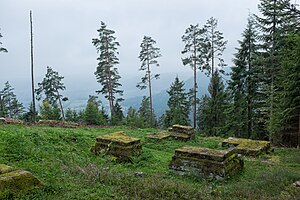Königswart ruins
| Königswart ruins | ||
|---|---|---|
|
View over the Königswart ruins into the Murg Valley |
||
| Creation time : | 1209 | |
| Castle type : | Hilltop castle | |
| Conservation status: | ruin | |
| Place: | Baiersbronn -Röt-Schönegründ | |
| Geographical location | 48 ° 34 '36.8 " N , 8 ° 24' 29.9" E | |
| Height: | 785 m above sea level NN | |
|
|
||
The Königswart ruin is the ruin of a hilltop castle at an altitude of 785 meters in the Murgtal (northern Black Forest) above the village of Schönegründ, a district of Röt in the municipality of Baiersbronn in the Freudenstadt district in Baden-Württemberg .
The ruin was in construction work on the road connecting L350 of Beautiful Gründ to Besenfeld (municipality Seewald discovered) and 1974 in cooperation of the Forestry Commission Klosterreichenbach with the Heritage Office Karlsruhe and the district office Freudenstadt by circular Archivar Dr. Wine exposed.
The building was built in 1209 by Count Palatine Rudolf von Tübingen . This is confirmed by a Latin inscription, which was almost completely recovered during excavations. Translated into German and completed, it reads: "Rudolf, Count Palatine of Tübingen, had this house built in the year after Christ's Incarnation in 1209, so that all who hunt here may remember him and pray for the salvation of his soul."
From 1828 to 1830 the remains of the ruin were removed. Today Königswart is a popular hiking destination, for example on Mittelweg of the Black Forest Association .
The earlier function of Königswart Castle is not clear. It is thought that it is a Gedächtnisbau (memoria) acted in memory of Count Palatine Rudolf. The building was also a border point to the sphere of influence of the Reichenbach monastery , which was under the priory of the Hirsau monastery and thus within the sphere of influence of the Counts of Calw . The part of the name “wart” may indicate a watch function. Below the ruins are the Königswart mine and the S. Philipps treasure trove , in which silver and copper were mined in the Middle Ages. The first written evidence of the mine dates back to 1448. However, the mining industry is probably much older and perhaps Königswart Castle should clarify the legal claim to it.
Web links
- Black Forest information
- Königswart ruins on the historical forest map (1609) by Gadner and Oettinger
literature
- Sönke Lorenz: Silver Copper Cobalt - Mining in the Black Forest . In: Gregor Markl, Sönke Lorenz (Hrsg.): Series of publications of the Mineral Museum Oberwolfach . tape 1 . Markstein Verlag, Filderstadt 2004, ISBN 3-935129-10-6 , Tübingen im Silberglanz: The Tübinger Pfennig and the rise of the city, p. 178-189 .
Individual evidence
- ^ Mathilde Schnürlen: History of the Württemberg copper and silver ore mining . Verlag von W. Kohlhammer, Stuttgart 1921, p. 43-47 ( archive.org ).



